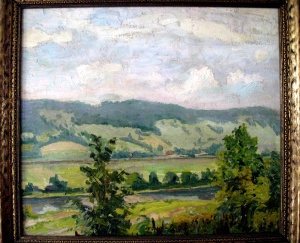George Davidson was born in Butka Poland on May 10, 1889. His family immigrated to the United States. They settled in Waterbury Connecticut. This area attracted many immigrants from diverse nations. As a student in the public schools he showed artistic promise. When he advanced to the upper grades he was encouraged by the highly esteemed local art teacher Mrs. Steel. At a later point he was accepted as a student to study at The National Academy of Design. New York City. (1909-1912) His instructors acknowledged his exceptional ability and he was awarded a scholarship to attend The American Academy Rome (1913-1916)
After a triumphant completion of his studies abroad. He held several prestigious teaching positions in the United States. He was an instructor of painting at Cooper Union New York City, (1925-1932). He was also a teacher of mural painting at the Yale School of Fine Arts. New Haven Connecticut.
At the onset of his career he was adventurous. George Davidson served his country in World WarI. He was commissioned as an officer with the rank of First Lt. by the American Red Cross. This position heralded his return to Italy. (1914-1919) When the Great War ended he was discharged from his duties. He was anxious to resume his career in the arts. The artist revitalized his spirits when he devoted much of his time to teaching art at Cooper Union and Yale.
Several years later in October 1929, the Great Depression was at hand. Many people including artists were jobless and homeless during the Herbert Hoover Administration. As hard times increased George Davidson became a WPA Artist under The Roosevelt Administration. George Biddle noted American Artist (1885-1973) was a classmate of president. Roosevelt. FDR (1882-1945) gave credit to Biddle who fought for legislation that provided jobs for unemployed artists. Mr. Davidson assisted the Federal Government as an Art and color consultant at the New York Worlds Fair in (1939-1940).
This flexible creator was not only a teacher, and a muralist but a noted portrait artist as well. He was chosen to paint several likenesses of distinguished banker’s entrepreneurs and industrialists in Connecticut. This untiring artist worked with Rogers on buildings at Columbia and Yale. He produced a hefty inventory of landscape paintings. During this period he was the focus of several one man shows and also participated in group exhibits. At the National Academy of Design along with the Chicago Institute of Fine Arts. His easel production required attentiveness along with much hard work. Easel painting was not as strenuous as wall painting. It provided the chance to be creative; it also provided the opportunity be free of some of the restraints involved in mural .work
George Davidson often worked on projects with fellow National Academician Eugene Francis Savage (1883-1978) both artists collaborated on various projects.thoruout the United States.
He received significant commissions for decorations in this country and nations abroad. He is primarily known for his outstanding mural decorations, his most important commissions are as follows The Buffalo Savings Bank, Buffalo New York, Chase National Bank New York, Sterling Library and Law School New Haven Ct. Mount Royal Hotel Montreal, Mutsui Bank Tokyo. State Building State Capitol Nashville Tennessee Harkness Chapel at Connecticut College for Women. New London Connecticut. Columbia Library New York the entrance lobbies International Telephone and Telegraph Corporation.
The artist was awarded a Medal of Honor for mural painting by The New York Architectural League in 1926. Davidson was a constituent of The Mural Painters Society. As his career progressed he was awarded full membership to The National Academy in 1942. . The artist had long and prosperous career. He died at his home in Connecticut 1965. Ref: Askart This painting was purchased from the estate.
